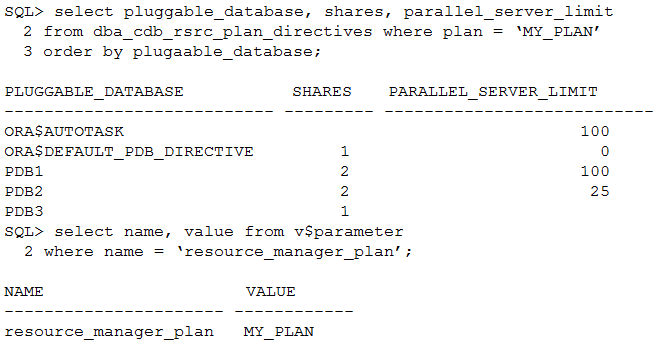Examine this output:

Which two are true? (Choose two.)
Examine this output:

Which two are true? (Choose two.)
Any PDB not specified in the plan will be unable to execute statements in parallel because they will use the default directive which sets the PARALLEL_SERVER_LIMIT to 0. For PDB3, since the PARALLEL_SERVER_LIMIT is not specified, it defaults to 100%. This means PDB3 can potentially use all available parallel execution processes at times when there is no contention.
A and B for me. A) PDB not specified in the Plan will be assigne to the DEFAULT_PDB_DIRECTIVE. This directive set PARALLEL_SERVER_LIMIT to zero. (No parallel server). B) PARALLEL_SERVER_LIMIT is not set for PDB3 Resource plan directive. The default value of 100% is used in this case.
Agree with you A. Correct as then a PDB will get assigned the default directive with parallel_server_limit set to 0 B. Correct as parallel_server_limit is not specified for PDB3 and it defaults to 100 Quote: https://docs.oracle.com/database/121/ADMIN/dbrm.htm#ADMIN14008 "If PARALLEL_SERVER_LIMIT is not specified, then it defaults to 100%." C. Incorrect. A PDB can use more resources: Quote from https://docs.oracle.com/database/121/ADMIN/cdb_dbrm.htm#ADMIN13777 "However, any PDB can use more than the guaranteed amount of a resource if there is no resource contention." D. Incorrect. Shares is a minimum guaranteed value. But a PDB can use more as explained above in C. E. Incorrect. Nothing confirms that there are only 3 PDBs attached. There may be others using the default pdb directive. Then the share for PDB2 is not 20% F. Incorrect. parallel_server_limit is an upper limit.
I was wondering that since the default directive with parallel_server_limit set to 0, how is it that other PDB will get share (for your explaination of F) since they wont be allowed to run parallel?
The default value is 100 as described here: https://docs.oracle.com/en/database/oracle/oracle-database/18/multi/using-oracle-resource-manager-for-pdbs-with-sql-plus.html#GUID-3E84009E-5CD6-46B8-84D3-BE775D58D9AA
I think D and F.
B and F are the correct answer as per my knowledge.
I believe it's AE.
In my opinion, B,F are correct.
Agree with SMagny and Alejandrrro. Options A,B
BE https://docs.oracle.com/database/121/ADMIN/cdb_dbrm.htm#ADMIN13786 + https://docs.oracle.com/database/121/ADMIN/dbrm.htm#ADMIN14008: The number of active parallel execution servers across all consumer groups exceeds the PARALLEL_SERVERS_TARGET initialization parameter setting. This condition applies regardless of whether you specify PARALLEL_SERVER_LIMIT. If PARALLEL_SERVER_LIMIT is not specified, then it defaults to 100%.
A and E E because of: https://blog.dbi-services.com/cdb-resource-plan-shares-and-utilization_limit/
not A, "Any PDB that is part of the CDB and does not have directives defined for it uses the default PDB directive. "
and DEFAULT_PDB_DIRECTIVE parallel is 0. so, A is correct.
ithink bf
A- Incorrect : If PARALLEL_SERVER_LIMIT is not specified, then it defaults to 100% REF: https://docs.oracle.com/database/121/ADMIN/dbrm.htm#ADMIN14007 https://docs.oracle.com/en/database/oracle/oracle-database/19/multi/using-oracle-resource-manager-for-pdbs-with-sql-plus.html#GUID-3E84009E-5CD6-46B8-84D3-BE775D58D9AA When you do not explicitly define directives for a PDB, the PDB uses the default directive for PDBs. B - Correct : If PARALLEL_SERVER_LIMIT is not specified, then it defaults to 100% C - Incorrect: PDB1 is NOT always limited to 40% of the available system resources regardless of demand. D - Incorrect : When you do not explicitly define directives for a PDB, the PDB uses the default directive for PDBs., default is 100% E: Incorrect : available system resources = utilization_limit and parallel_server_limit F: Correct : parallel_server_limit =25
A is correct since itll default to DEFAULT_PDB_DIRECTIVE that was set to 0.
F: is incorrect, "parallel_server_limit" does not guarantee anything, it limits the resource to 25% ! https://docs.oracle.com/database/121/ADMIN/cdb_dbrm.htm#ADMIN13786
BF = correct answers
Question: Which three are true about performing an Oracle Database install on Linux? (Choose three.) Response: A. The Oracle database administrator must be granted access to the root operating system account to tun root privileged scripts. B. It allows you to select the languages supported by the Oracle database server. C. The runfixup.sh script can install missing RPMs. D. The Oracle Preinstallation RPM can be used to configure the Oracle database installation owner, the Oracle Inventory group, and an Oracle administrative privileges group. E. It can be done after installing Grid Infrastructure for a Standalone Server. F. It can be done before installing Grid Infrastructure for a Standalone Server. G. The Oracle Preinstallation RPM must be used to configure the Oracle database installation owner, the Oracle Inventory group, and an Oracle administrative privileges group. D, E and F are correct. Any comments???
When you do not explicitly define directives for a PDB, the PDB uses the default directive for PDBs. In this case the default directive sets the value 0 for parallel_server_limit. In this case I understand that PDB3 cannot use resources in parallel. So option A seems correct to me.
The correct options ar A and F in my opinion.
I think AB
A,B for sure
A and B.